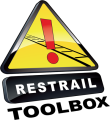12.3 Tracking spotlight linked to a movement sensor
This measure refers to technology to influence people at risk by motion sensitive lighting combined with movement tracking spotlights. This measure is used as a sudden lighting system with tracking of the person. Useful for situations in which technology can be used to provide a warning to people who move into an area that they should not enter, or behave in a way that places them at risk, with the intention of influencing the person to modify their behaviour and move to a place of safety.
- Check the laws on human integrity in your country before making the plans.
- Check if you have a higher number of suicides during night time.
- The sensor needs to be able to react only to persons who are in its range.
- The effect will increase when combined with a follow-up measure as surveillance or sound warnings.
- Make sure there are no obstacles within the range of the tracking light behind which persons can hide.
- Lights should not be too intense in order to avoid blinding or distracting train drivers and interfering with railway signals installed on the tracks.
- Be aware that light pollution can cause acceptance risks with neighbours and nature conservation organisations. Communicate before installing. Maybe not to be used in rural nature areas because of light pollution.
- Impact of the spotlights for the people living in the direct environment could be an issue. For dispelling light sources there can be problems with national laws on human integrity.
- Effective only during night time.
- It is expected that the effects are durable.
- Studies outside of the railway setting have shown the benefits of lighting in reducing crime and anti social behaviour. This measure could also reduce railway crime and improve security.
- In Japan, introduction of blue LED lights at 11 stations resulted in 84% decrease in the number of suicides between 2000-2010 compared to other 60 stations without blue light (Matsubayashi et al., 2012).
- The installation of blue lights on platforms, even were they to have some effect in preventing railway suicides at night, would have a much smaller impact than previously estimated (Ichikawa et al., 2014)
- Visible light of short wavelength (blue light) may cause a photochemical injury to the retina, called blue-light hazard. This blue light hazard may come from the interaction of blue light with molecules constituting the retina or accumulating in the retina with age or in pathological conditions. Studies indicating a blue light hazard within the intensity range of natural light to the retina are based on animal experiments. The relevance of these experimental data for human pathological conditions is not very clear. In general, the probability that artificial lighting for visibility purposes induces any acute pathologic conditions is low (Kadotani et al., 2014).
- Other literature suggests that once a person has crossed the “decision-line”, it will require much more than a barrier or a blue light to stop them (Bhui et al. 2013).
- Anti-suicide lighting is used in The Netherlands on a broader scale with positive results at suicide hotspots. ProRail started to evaluate this measure in 2012. At the end of 2012 the number of incidents were counted, before and after the implementation of the lighting. At 3 pilot locations there was a decrease of 30%, 80% and 100%. At one location there was an increase of 31%. Due to the limited data it is not yet possible to have a valid conclusion. The system is in place and further evaluations will be made after a longer period of time.
last update: 2025-02-12 Print

